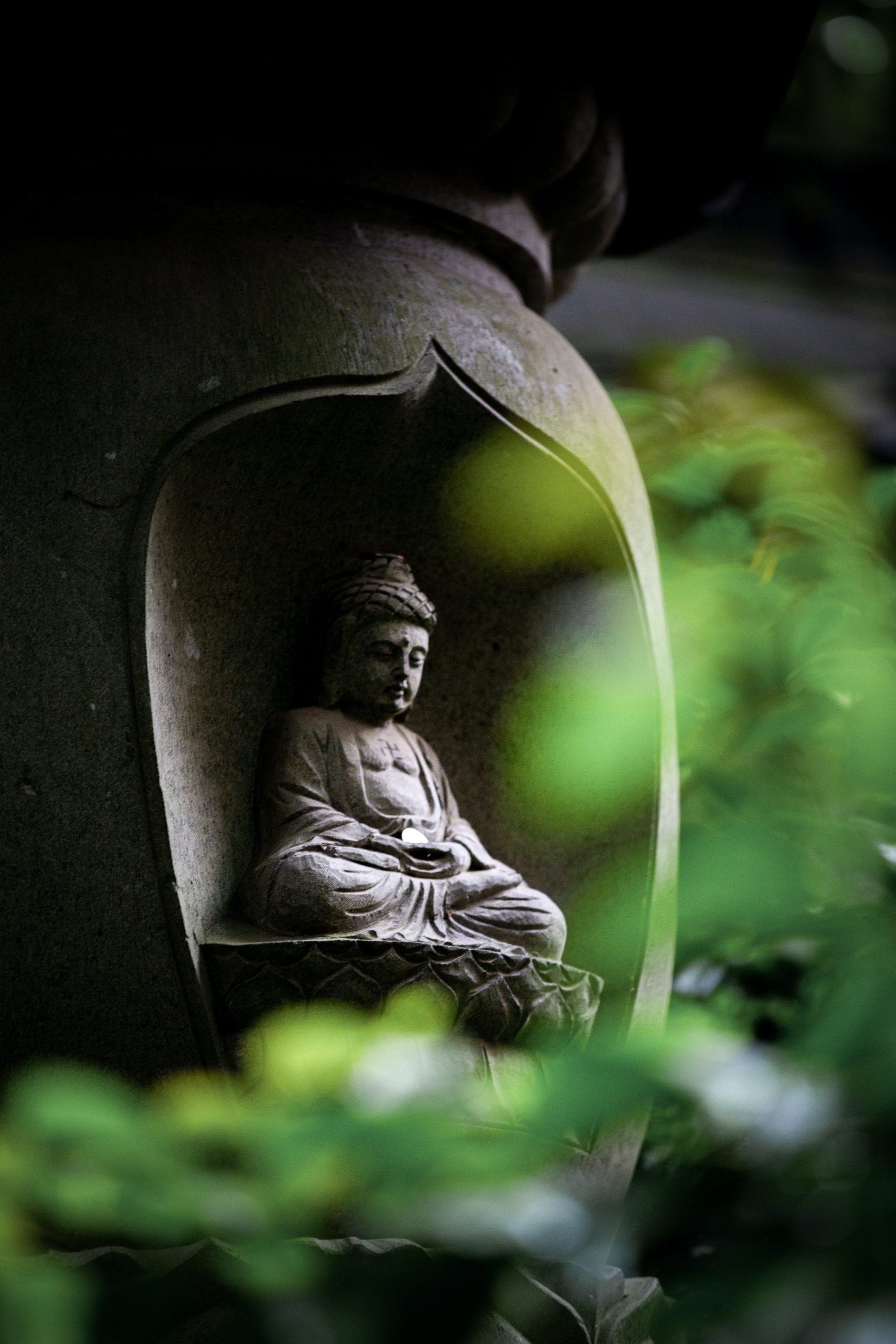
Also known as the Eight Bringers of Good Fortune – which is a more appealing title – The Noble Eightfold Path reveals how you can dissolve suffering by adopting eight “right” ways of experiencing the world:
Buddha said that his teachings are not to understand reality itself but to learn how to experience reality. This is achieved by contemplating your experiences and identifying what you did to cause the experience.
The natural laws of the Universe dictate that for every action there is a reaction. In science, this is known as cause and effect. Your experiences are caused by your actions. This is why ancient philosophy says individuals are responsible for creating their own reality.
What the Buddha came to realise under the Peepal tree, is that there is a right way to work with the laws of nature and a wrong way. Choosing the right path and practising the Noble Eightfold Path will bring “Good Fortune.” And vice versa.
Each of the eight aspects of the Noble Path can be integrated into everyday life. You are already doing them naturally, both good and bad, without actually being consciously aware of the effect your actions will cause later.
But what the Noble Eightfold Path teaches you, is to live a balanced, simple life, and seek desires moderately rather than excessively. Sometimes personal sacrifices are needed in the moment before you reap rewards in the future.

The understanding of the “right way” can sometimes be difficult depending on the situation you find yourself in. The way in which you react to a situation should be the right thing to do to reap the rewards.
Most times you will know what to do, other decisions are instinctive. But then there are other times when you need to be aware of your intuition. You always get a feeling that confirms whether the decisive action you take is right or wrong. If it feels wrong, then you have to enforce discipline – make the sacrifice.
Buddha’s Noble Eightfold Path is a guideline for the aspects of your personal nature that you should be conscious of doing right. There are also some symbols and philosophical stories to help you understand and remember what the “right” ways are.
The first signpost on the path is the ability to take the right view. This essentially means our understanding of the world and accepting things simply as they are.
Taking the wrong view is when you have expectations of how you perceive an outcome should happen. This can be when you have a desire that does not manifest, how you hope things will be or you are afraid of how things will turn out.
By abandoning hopes, fears and expectations, you can take a simple approach to life and better prepare yourself for eventualities when they happen as described in the four noble truths.
In Buddhist symbolism, mustard seeds are used to reflect right understanding. When a young woman went to see Buddha distraught having lost her child, the sage told her to collect a mustard seed from every household that had not suffered a bereavement. She returned empty-handed.
The lesson here is that the woman is not alone in her sorrow, and it is only her expectation of how life should be that is causing her to suffer. Mustard seeds are also a symbol of overcoming adversity.
Right thought proceeds right view. Once you have abandoned expectations, hopes and fears, you are free to simply go with the flow of life. Instead of attempting to manipulate an outcome you most desire, life happens for you.
For example, if you want somebody to do something and they don’t do what you want, you might get angry or moody. This not only affects how you feel, not to mention your physiology, but it also causes friction and an unpleasant environment.
And what’s the point of that?
By keeping your thoughts and intentions pure, you do not harbour preconceived ideas of how things should be, you just accept things and people for how they are, thereby improving your relationships and your environment.
The symbolism for right thought is the mirror as it represents truth and purity. What you see in a mirror is an exact replica of reality without being obscured with perceptions that create an illusion.
The steps of the Noble Eightfold Path flow into each other. Right speech comes naturally once you master right intention. When your thoughts are pure, you no longer feel embarrassed about explaining your thoughts and feelings to others. You can simply be yourself without caring what other people think about you.
If people judge you for having opinions and preferences that are different to their own, that is their problem, not yours. Perhaps their thoughts are not pure.

Because you do not need to feel the need to be careful or hesitant about what you say, you speak with more confidence and purpose. You simply say what needs to be said, and because you sound genuine, other “right” people generally believe you anyway or at least respect your opinion and preferences.
Right speech earns you respect and trust.
There are also times when in the heat of the moment, you might make a cutting remark and say things you don’t really mean and later regret. Right speech eliminates criticism of others if you are aware that criticism is not the right thing to say. Constructive criticism is a better approach. You will be able to communicate effectively and thoughtfully so that the truth is brought out in any wrongdoing.
Right speech is symbolised by the conch shell which was thought to have been used as a horn to carry the voice in some cultures. In symbolism, the conch shell represents “awakening”, which is another way of saying self-aware. Self-awareness dispels ignorance.
Read more about the symbolic meaning of the conch shell here.
Right action is also another discipline that will improve once you have mastered the first two folds of the Noble Eightfold Path. It teaches individuals to take an ethical approach in life and not cause harm or loss to another person or animal.
It also relates directly to speech in that the Buddha says you should honour promises and agreements. Do not make promises or agree to do something you will not carry through. If at the time you make a promise you intend to go through with it, make sure your intention is right and fulfil the promise.
This is especially so for addictive tendencies you intend to overcome and promises that you make to yourself that will improve your experience of life. If you are dieting and know you shouldn’t eat cake, don’t buy a cake. If you are an alcoholic stay away from bars and the booze aisle.
How many times have you found yourself in a situation when you know you shouldn’t do something, but do it anyway? For most people, it happens almost every day.
The symbol for right action is the Bilva fruit which is associated with Lord Shiva in Hindu. Shiva, of course, is known as the Destroyer, and sometimes you need to call on his power of strength to distinguish the burning needs of your desire. The “Destroyer” makes sacrifices that transform old habits and pave the way for new ways of being. It’s the old death and rebirth story found in the myths of every culture that ever existed.
The path of right livelihood does not necessarily mean having the right job for you, it means performing the right jobs in the right way. This path is easier to follow if your line of work is something you are passionate about, but the most important factor is that whatever you do for a living provides a benefit to the wider community.
What Buddha meant is your work should not harm others or show disrespect for any form of life. If your role in society cheats on people or purposely creates obstacles (i.e. politics), you also erect a barrier against your personal evolution.
It is right that you earn a living to contribute to your local community through the service you offer in the course of your business. It is also right that you pay taxes to improve the infrastructure in your local community. It is not right to perform jobs that do not provide any benefit to people. Food brands that push ultra-processed crap onto supermarket shelves should hang their heads in shame.
If you don’t enjoy your job, consolidate yourself with the wisdom of right livelihood. Serving people and contributing to society in constructive ways is the right thing to do. Be grateful that you have the opportunity to play your part in helping the wider community.
Right livelihood is represented by curd in Buddhist symbolism. Making curd is a long, slow process that requires defilement. It is therefore likened to a person’s career. But curd, a type of fermented milk, is a form of nutrition. In Buddhism, it is thought that curd was the first nourishing meal the Buddha received after attaining enlightenment.
The type of job you have can taint your mind with bitterness, resentment and jealousy. Like curd, the mind is defiled. So you must learn to appreciate that whatever job you have, the benefit you offer at the other end is what matters the most. Who are you nourishing?
You can either let your job bring you down and needlessly suffer. Or you can recognise the value you provide to people and feel good about the benefits you provide.
Right effort helps to bring your life into balance. Sometimes you can strive too hard to achieve things you are not good at, or struggle to overcome a negative aspect of your character.
Self-discipline can be a difficult path to tread, but you also need right balance in your life. Whereas right action calls for you to make sacrifices, right effort teaches us to cultivate the process of transformation with balanced and productive measures.
When you struggle, you develop negative tendencies which makes the effort of changing a losing battle. With discipline and a focused structure to engage in right effort, you more readily adopt a positive attitude which subsequently has positive results.
Right effort is represented by Durva Grass in Buddhist symbolism as it is resilient and slow-growing. Buddha taught that it takes time to attain enlightenment and that the practitioner should have patience. The same can be said for any kind of transformation you want to make in your life. Some things take time. Patience is a virtue.
Right mindfulness teaches you to be clear on your intentions and live in the moment. When performing a task, no matter how simple, it is necessary to have clarity and precision in everything we do, whether washing, eating or performing a difficult chore.

Of all the practices in the Noble Eightfold Path, right mindfulness is the most difficult to master as it takes greater powers of concentration to pay attention to the tiniest details, posture, attitude, expression, reaction, and speech, but once mastered we can improve our performance in everything we do.
This step challenges you to change the way in which you naturally use your brain. Because you are so used to operating on auto-pilot it is natural for your mind to wander. Whilst nostalgia and contemplation are not necessarily a bad thing, there is a time and a place for meditation.
But really, being mindful of whatever you are doing is meditation in itself. Meditation does not strictly involve sitting in the lotus position and intentionally performing Dhyana. Meditation involves paying attention. Right mindfulness forms the basis of meditation.
Whereas some meditation techniques are purposefully designed to detach your thoughts from the world, right mindfulness is the opposite – it teaches you to embrace the world around you by being present and fully aware of the experience.
Right mindfulness is also closely related to vipassana meditation which teaches you to see things for how they really are and to be aware of how your thoughts, actions and emotions create your experiences in life.
When you become aware of how you create an experience, you can see yourself more clearly. Self-awareness is the catalyst for healing emotional wounds and transcending ego. In this space, you move away from surviving and into thriving.
You have an obligation to yourself and others to be the best version of yourself. By recognising and acknowledging subconscious programs that control you, it is easier to improve your relationships, environments and circumstances.
The medicine ghi-wang, abstracted from the gallstone of cows and elephants, is used to represent right mindfulness, because of its magical essence that soothes and strengthens. Gautama Buddha recognised that right mindfulness was the antidote to the self-ignorance that ultimately causes suffering.
Right now I am struggling to concentrate – which is ironic just as I come on to right concentration. In my defence, I have been sitting here for three hours and the time is 01.42!
The final step of the Noble Eightfold Path is an extension of right mindfulness, and it teaches you to refrain from absentmindedness and your innate tendency to be easily distracted whereby your mind wanders and you become preoccupied with desires.
But the modern world is deliberately designed to prevent you from becoming absorbed in the moment. The captivation of entertainment and speculation has pre-programmed the mind to seek external distraction, stimulation and rewards. Subsequently, when you are silent and still, you feel restless.
Whereas right mindfulness disciplines you to become absorbed in the now, to prevent your mind from wandering, right concentration teaches you that concentration helps to achieve your objectives in life. For example, in the Essential Self-Development Programs, the Creator Tools teaches you a technique which can be used to manifest life goals and desire outcomes.
Oftentimes it requires strength, courage and patience to endure daily processes, but by directing the mind to the experience of “now”, you will be calm and at peace with the world. Ultimately, how you spend your time is all the more special. Essentially you feel more connection, joy, love, happiness and fulfilment.
The symbol used to express right concentration is the red powder, Cinnabar. In Buddhism, red represents control and mastery of the mind and emotions which can be put to better use in the effort to achieve nirvana – liberation from suffering.
The Noble Eightfold Path takes time, patience and dedication, but by engaging in all eight steps every day, little by little, you become stronger and more adept at your daily activities. Just remember, Buddha almost killed himself learning this.
